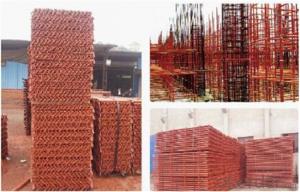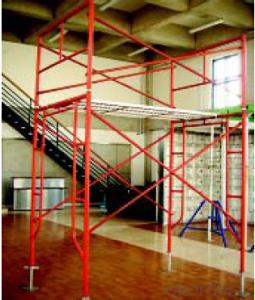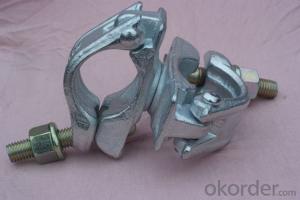scaffolding forged irregualr coupler
- Loading Port:
- Nanjing
- Payment Terms:
- TT OR LC
- Min Order Qty:
- 1000 pc
- Supply Capability:
- 30000 pc/month
OKorder Service Pledge
OKorder Financial Service
You Might Also Like
Drop forged irregualr coupler
1.size:48.3mm×63mm
2.weight:2.3kg
3.Material: Q235/225/345
4.surface :self-color / zinc plate / electro galvanized / HDG or painted
5.Standard: EN74 ,BS1139
6.Anti-rust ,skidproof ,high breaking strength
7.Durable finish, reliability, low maintenance, corrosion resistance, robust construction and high tensile strength
8. OEM serice is available
SPECIFICATIONS:
1 MATERIAL:Q235
2 SWIVEL AND DOULE RIGHT ANGLE COUPLER
3 DROP FORGED AND PRESSED
4 BS1139 AND EN74 STANDARD
5 SIZE:48.3*48.3MM
6 PRESSED AND DROP FORED SWIVEL AND FIXED COUPLER/PUTLOG COUPLER/SLEEVE COUPLER/INNER CONNECTOR/BEAM COUPLER ETC.
Pressed swivel coupler 1.02kg galvanized/ hot dipped galvanized
Pressed fixed coupler 0.85kg galvanized / hot dipped galvanized
DROP FORGED SWIVEL COUPLER 0.98kg galvanized / hot dipped galvanized
DROP FORGED SWIVEL COUPLER 1.12kg
DROP FORGED PUT LOG COUPLER 0.62KG galvanized / hot dipped galvanized
SLEEVE COUPLER 1.0KG galvanized / hot dipped galvanized
DROP FORGED FIXED BEAM COUPLER 1.45KG galvanized / hot dipped galvanized
DROP FORGED SWIVEL GRINDER COUPLER 1.5KG galvanized / hot dipped galvanized
7 SUITABLE FOR PIPE DIAMETER:48MM,48.3MM,60.3MM
8 Payment terms:30%TT deposit, balance against BL copy or LC at sight
9 FOB .CIF.C&F ,CFR acceptable
10 Delivery time;20-30days after receiving deposit
- Q: Are steel tube couplers compatible with scaffolding fall arrest systems?
- Yes, steel tube couplers are compatible with scaffolding fall arrest systems.
- Q: Are there any international standards or regulations for steel tube couplers in scaffolding?
- Yes, there are several international standards and regulations for steel tube couplers in scaffolding. One of the most widely recognized standards is the EN 74-1 standard, which is a European standard for couplers used in temporary structures such as scaffolding. This standard specifies requirements for dimensions, materials, and mechanical properties of couplers. Additionally, the American National Standards Institute (ANSI) has developed standards for scaffolding couplers, such as ANSI/SSFI SC 100-5/05. This standard sets requirements for the design, testing, and performance of couplers used in scaffolding systems. Furthermore, the International Organization for Standardization (ISO) has published ISO 9001, which is a quality management system standard that can be applied to the production of steel tube couplers. This standard ensures that manufacturers follow a set of guidelines to produce couplers that meet certain quality requirements. It is important for manufacturers, suppliers, and users of steel tube couplers in scaffolding to adhere to these international standards and regulations to ensure the safety and reliability of scaffolding systems. Compliance with these standards helps to guarantee that the couplers used in scaffolding are of high quality, adequately tested, and able to withstand the loads and stresses associated with scaffolding structures.
- Q: Can steel tube couplers be used for scaffolding on uneven surfaces?
- Yes, steel tube couplers can be used for scaffolding on uneven surfaces. The couplers are designed to connect steel tubes securely, allowing for flexibility and adjustment to accommodate uneven ground. This ensures stability and safety while erecting scaffolding on varying terrains.
- Q: Are there any limitations to the use of steel tube couplers in scaffolding?
- Yes, there are limitations to the use of steel tube couplers in scaffolding. One limitation is that they may not be suitable for certain types of scaffolding structures that require specialized connectors. Additionally, steel tube couplers have weight limitations and may not be able to support heavy loads. It is also important to consider the compatibility of different coupler types and sizes, as mismatched couplers can compromise the stability and safety of the scaffold.
- Q: Can steel tube couplers be used for angled connections in scaffolding?
- Indeed, angled connections in scaffolding can be achieved with the use of steel tube couplers. These couplers possess great versatility, allowing them to connect steel tubes at various angles, including angled connections. By securely gripping the tubes, they establish a robust and dependable connection, which is frequently employed in scaffolding systems to construct stable and trustworthy structures. Their adjustable nature enables easy attainment of the desired angle. Moreover, steel tube couplers exhibit durability, enabling them to withstand heavy loads and adverse environmental conditions, rendering them perfectly suited for angled connections in scaffolding.
- Q: Can steel tube couplers be used in confined spaces scaffolding projects?
- Yes, steel tube couplers can be used in confined spaces scaffolding projects. Steel tube couplers are commonly used in scaffolding systems to securely connect tubes and provide stability. They are versatile and can be used in various project environments, including confined spaces, as long as they are properly installed and meet safety regulations.
- Q: How do you calculate the required number of steel tube couplers for a specific scaffolding project?
- To calculate the required number of steel tube couplers for a specific scaffolding project, you need to consider a few key factors. First, determine the total length of tubes that will be used in the project. This can be done by measuring the distance between each platform or level of the scaffold, as well as the vertical height required. Next, identify the types of connections that will be made using the steel tube couplers. For example, if you plan to connect two tubes in a straight line, you will need one coupler. However, if you plan to create a corner or an intersection, you may need multiple couplers to ensure stability and safety. Additionally, consider the load-bearing capacity of the scaffolding, as this will determine the spacing and number of couplers required. Consult the manufacturer's guidelines or industry standards for the specific load ratings of the couplers and calculate the maximum load capacity of each connection point. This will help determine the number of couplers needed to distribute the load evenly throughout the structure. Lastly, account for any additional factors such as safety regulations or local building codes that may specify certain requirements for the number of couplers needed. By considering these factors, you can accurately calculate the required number of steel tube couplers for your specific scaffolding project. It is always recommended to consult with a professional engineer or scaffolding specialist to ensure compliance with safety standards and regulations.
- Q: Can steel tube couplers be used in temporary scaffolding structures?
- Yes, steel tube couplers can be used in temporary scaffolding structures. Steel tube couplers are commonly used in scaffolding systems to securely connect steel tubes together, ensuring the stability and strength of the scaffolding structure. These couplers are designed to provide a reliable and durable connection, making them suitable for temporary scaffolding structures.
- Q: Can steel tube couplers be used in both horizontal and vertical connections?
- Yes, steel tube couplers can be used in both horizontal and vertical connections.
- Q: What are the different load rating classifications available for steel tube couplers?
- The different load rating classifications available for steel tube couplers include Light Duty, Medium Duty, and Heavy Duty.
Send your message to us
scaffolding forged irregualr coupler
- Loading Port:
- Nanjing
- Payment Terms:
- TT OR LC
- Min Order Qty:
- 1000 pc
- Supply Capability:
- 30000 pc/month
OKorder Service Pledge
OKorder Financial Service
Similar products
Hot products
Hot Searches

























